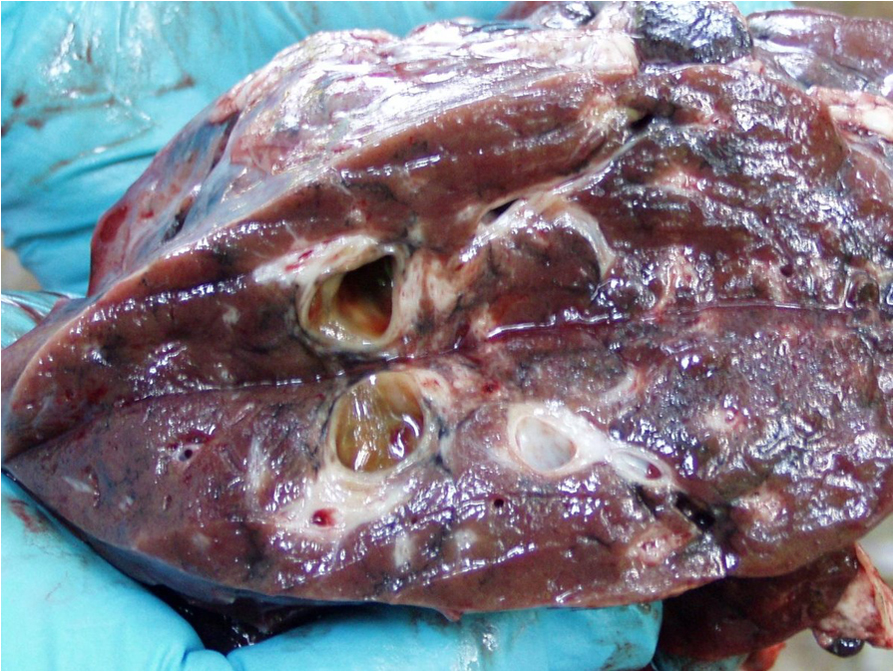The giant liver fluke or deer fluke, Fascioloides magna, is a parasitic flatworm that may grow up to 8 cm long, 3 cm wide, and 2-5 mm thick. They have a multi-host life cycle, using snails as intermediate hosts and white-tailed deer, elk, and caribou as the definitive hosts, (where the parasite completes its life cycle).
There are usually no clinical signs, but signs can appear dependent on the species.
Transmission most often occurs in spring and late summer or fall. Mature F. magna flukes residing in the liver of an infected ruminant release up to 4000 eggs per day. These are carried to the small intestine thru the bile ducts and shed in the feces.
Eggs hatch in water and release free-swimming larvae, who then seek out a suitable snail to infect. Larvae mature within the snail and are released, usually at night, to encyst on aquatic plants. The encysted larvae are transmitted to a new host when the plants are ingested.
Upon ingestion by a suitable definitive host, the larvae activate in the gastrointestinal tract and migrate through to penetrate the liver.
Fluke infection is diagnosed via necropsy and visual examination of the liver for parasites. Feces from definitive hosts may be examined microscopically for the parasite eggs, and DNA extraction techniques may be used to test for Fascioloides species in snails.
In aberrant hosts such as moose, the parasite does not complete the life cycle and fecal exam is not useful for diagnosis.
There are no products are approved for treatment against this fluke in the USA.
In the liver the parasitic worms often look like leeches or blood clots. They are purple-gray in color and long, flat, and ovular in shape.
Definitive hosts include mule deer, black-tailed deer, red deer and fallow deer, but in North America, white-tailed deer, elk, and caribou are the only hosts that contribute significantly to maintenance of F. magna populations.
Dead-end hosts, in which the flukes reach the liver but rarely mature and produce eggs, include moose, cattle, bison, yak, horses, swine, and llamas.
Mature F. magna flukes release eggs which are carried to the small intestine via the bile ducts and excreted in the feces. Eggs hatch in water and release free-swimming larvae, who then seek out a suitable snail to infect. If they do not succeed in finding a snail, the larvae will die within 1-2 days.
The encysted larvae are ingested primarily at two time periods – in late summer and fall, when many larvae are present in the environment, and in the spring, when deer often seek fresh green vegetation associated with wetlands.
Immature flukes migrate through the liver until they are encapsulated in groups of two or more individuals. Within these capsules, flukes grow and develop into adults and subsequently lay eggs, completing the life cycle. In aberrant hosts, some larval flukes may migrate abnormally and penetrate other tissues beside the liver, such as the lungs. However, these errant flukes will generally die before reaching maturity and contributing further to the population.
In deer, which are the natural hosts, infections don’t appear to produce clinical signs. In other species such as moose or cattle, some liver related signs may appear due to inappropriate migration. Heavy infections in moose may cause significant liver damage but it isn’t clear how this parasite contributes to overall mortality. Sheep generally show poor body condition and abdominal discomfort, and some can suddenly die due to liver hemorrhage.
According to reports, oxyclozanide and triclabendazole can be effective against F. magna in both free-ranging and captive deer. Rafoxanide has been used successfully in cattle, and albendazole, clorsulon, and closantel have shown promise in sheep.
In livestock, the parasite may be controlled by preventing herds from grazing on snail-infested pastures, particularly those shared with infected deer, or by restricting feeding of hay harvested from areas where the parasite is typically present



